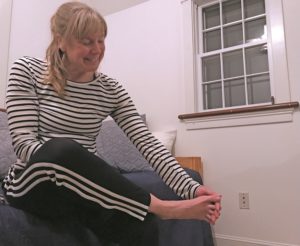Feet are unsung heroes. They carry you for thousands of steps a day. And when you walk or run, every time your foot hits the ground, it’s loaded with an impact force that is equal to one-and-a-half to three times your body weight.
Are you thanking them for all that? Most of us simply stick them in our shoes and forget about them. Unless something starts to hurt.
Since an ounce of prevention is worth a pound of cure, here are some preventive measures to keep your feet healthy and happy.
First, regular exercise — and, yes, I mean special movements for your feet — will preserve mobility and strength, which helps your feet function better. These are three of my favorites:
- Toe stretch and ankle roll: while sitting, cross one ankle over the opposite thigh. Lace your fingers between your toes to separate them and push them back into extension. This will stretch the muscles on the sole and the plantar fascia. Next, gently roll the ankle in a circle five times, reverse direction, and repeat.
- Toe point and curl with ankle pump: sit with one leg extended, foot off the floor. Point and curl your toes down, then flex the ankle and straighten the toes, stretching them up. Repeat 10 times. Now switch it up — point down at the ankle but stretch your toes up, then flex the ankle and, at the same time, bend or point your toes down, 10 times.
- Calf stretch: place your hands against a wall and step one foot back. Bend the front knee and lunge forward while keeping the back heel on the floor. You should feel tension in your calf and/or your Achilles tendon. Do two repetitions of at least 30 seconds on each leg.

Self-massage is another treat for your feet. And it improves circulation and the mobility of the soft tissue in your tootsies. As a bonus, foot massage has been shown to decrease stress.
Here’s how to do it:
- Find a small ball. Though there are wooden foot rollers made especially for this, and they’re nice, a golf or racquet ball works just fine.
- Sit in a chair with one foot on top of the ball, resting on the area just in front of your heel.
- Roll the ball along the sole of the foot to the base of your toes. Go back and forth several times. Try rolling along the inner and outer edges of your foot as well as straight up the middle. Start with light pressure and gradually increase.
- It should feel good, but if you find tender spots you can apply sustained gentle pressure.
Finally, you want to make sure your hooves have a happy home, so buy good-quality shoes. They should provide a balance between cushioning and support. A shoe that’s too rigid will cause a loss of mobility, while the minimalist models don’t provide enough support for most people. Size does matter: proper fit is crucial. Get your feet measured when you shop. You’d be surprised how much your shoe size or width can change over time. Always try on shoes at the end of the day, to account for swelling.
Unfortunately, even the best shoes don’t last forever, so be sure to replace them when they wear out. Conventional wisdom says you should replace your walking or running shoes after 300-500 miles. Most runners track their mileage more diligently than their checkbooks, but what if you’re not sure about miles or you do other kinds of workouts? Here are some signs that you need new kicks: the heel is breaking down, you feel that the cushioning has compressed and no longer has any bounce, or you develop foot pain without any apparent cause.
It’s worth taking good care of your feet. May they give you many more miles.



